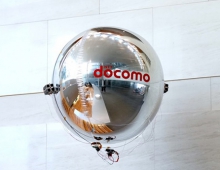
NTT Shows Super High Resolution Screen
Japanese researchers of NTT have developed a 'super high resolution' compression system and screens for the generation of images after high definition TV. The screen is based on the superhigh-resolution (SHR) codec for video.
The core of the technology is the 1-chip HDTV codec LSIs (VASA chips) that conform to MPEG-2 international standards. The SHR codec provides an output four times the resolution of HDTV - 2160 pixels high x 3840 pixels wide, or 5760 x 1080 for long screens that combine existing HDTV broadcasts.
Generally, the compression and decompression of large images having a resolution in excess of HDTV required that the entire screen be divided and processed in HDTV units. In this configuration, however, information could not be exchanged between encoders, so picture quality could differ among the encoders depending on the image.
To solve those lingering problems, NTT developed a cooperative rate-control technology that enables realtime information exchange between encoders. As a result, such variations in picture quality are prevented and also higher-quality pictures are achieved, according to the company.
In addition to real-time transmissions such as live broadcasts of concerts and soccer matches at 'Satellite Stadiums,' this system can be used for recording and playback, and so is expected to find applications in SHR image fields of the future, including digital cinema, stereo 3D TV, and multi-angle TV.
NTT plans to commercialize this technology with the aim of achieving next-generation SHR video communications superior to HDTV and promoting SHR video distribution services.
Generally, the compression and decompression of large images having a resolution in excess of HDTV required that the entire screen be divided and processed in HDTV units. In this configuration, however, information could not be exchanged between encoders, so picture quality could differ among the encoders depending on the image.
To solve those lingering problems, NTT developed a cooperative rate-control technology that enables realtime information exchange between encoders. As a result, such variations in picture quality are prevented and also higher-quality pictures are achieved, according to the company.
In addition to real-time transmissions such as live broadcasts of concerts and soccer matches at 'Satellite Stadiums,' this system can be used for recording and playback, and so is expected to find applications in SHR image fields of the future, including digital cinema, stereo 3D TV, and multi-angle TV.
NTT plans to commercialize this technology with the aim of achieving next-generation SHR video communications superior to HDTV and promoting SHR video distribution services.





















